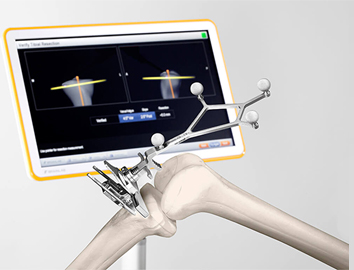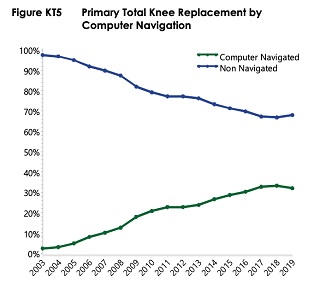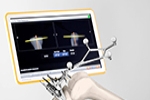Updated on: 26 September, 2021
Anyone who has been following my blog will know how much I like computer navigation for knee replacements. I frequently get asked why I am so passionate about it. There are lots of claims being made about new technologies available for knee replacements so making a decision about your knee can be very confusing. The bottom line is that computer navigation is the only technology that has been proven to improve the alignment, functional outcomes and long term results of knee replacements.

What is computer navigation?
The first step with computer navigation involves the creation of a three dimensional digital model of your knee in real time during surgery. This is done using safe infrared technology. It doesn’t require a CT scan and there isn’t any harmful radiation. In the corner of the room is an infrared emitter receiver attached to a computer. The surgeon uses temporary pins in the bones and a hand held probe with infrared reflective balls attached to precisely map out the three dimensional anatomy of your knee. The computer then calculates where to place the bone cuts to achieve the optimal alignment and balance. The cutting jigs are then positioned, guided by another infrared enabled instrument. The surgeon is in total control of this process, can double check the computer’s plan and easily make real time adjustments if necessary. Using this technology, it is possible to make the bone cuts to within half a degree of accuracy, which is more accurate than a human eye can detect.
The following video explains how this works:
Why does alignment matter?
Numerous studies have shown that poor alignment is detrimental to long term outcomes of knee replacements. It has long been accepted that just 3 degrees of error in alignment leads to an increased rate of failure through loosening of components. This is because assymetrical forces through the shin bone component cause tiny rocking movements between the implant and the bone that gradually cause them to separate. This is called ‘loosening’ and leads to pain and failure of the knee replacement requiring major revision surgery to correct. (1)
That all sounds great but does it work?
The best evidence doctors can use to make decisions is systematic reviews of randomized controlled trials. Such reviews have clearly shown that computer navigation improves the alignment of knee replacements compared to the traditional manual technique. (2,3).
It would be expected that this improved alignment would also lead to better outcomes for patients. The second of these reviews also clearly showed that this is the case. Patients with computer navigated knees have better scores for pain and activity in the first three years after surgery compared to non-navigated knees. (3)
What about long term outcomes?
We now have good evidence that computer navigation doesn’t just improve alignment and functional outcomes in knee replacements, it also reduces the long term failure rate. A recent detailed study by the Australian Orthopaedic Association National Joint Replacement Registry (AOANJRR) of over 44,000 computer navigated knee replacements showed that for patients under 65 there was a statistically significant reduction in the failure rate over time compared to non-navigated knees. At nine years after surgery the non-navigated knees had a 38% higher risk of failure due to loosening/lysis. (4)
So shouldn’t everyone be using it?
The following graph from the 2020 AOANJRR annual report shows that more and more surgeons are seeing the benefits of computer navigation. From 2003 to 2019 use in Australia increased from 2 to 32% of knee replacements. Users such as myself are however still in the minority. (5)

One possible reason is that computer navigation takes around 10 minutes longer. Another is there is a small risk of local pin site infection of 0.6%. These are however usually very simple to manage (6) and have far less impact on patients than the complex revision for poor alignment or implant failure that computer navigation prevents.
Another issue is the enormous amount of marketing being poured into competing and as yet unproven technologies such as patient specific implants and robotics. Both of these technologies are brand specific and in my view this marketing is driven by global multinational companies trying to lock hospitals and surgeons into the use of their brand of implants. Computer navigation can be used on most brands of knee replacement and so the large implant companies have no incentive to promote its use. As a result of this marketing, patients are requesting these other technologies even though there is little evidence they have any benefits. In fact, I have written previous blogs discussing the poor results of patient specific knee replacements and my safety concerns with robotic arm technology.
Conclusion
A comparison I like to use is of navigating when driving a car. The old technology is like using a simple map and this will get us there safely most of the time. Computer navigation is a bit like a GPS for the surgeon. The surgeon remains in control but the computer allows choosing the optimum route, gives advice during the journey, and if it does goes off track it is simple to use observation and experience to correct course. No other technology is so versatile.
Computer navigation has been proven to improve alignment, functional outcomes and long term failure rates and in my opinion is the gold standard for knee replacement surgery. I have been using computer navigation since I started private practice, and it is one of the reasons why my revision surgery rate for knee replacements is less than half of the national average.
To read more about my clinical results Click here.
If you would like to make an appointment to discuss knee replacement surgery my contact details are available here.
References:
- Abdel MP1, Oussedik S2, Parratte S3, Lustig S4, Haddad FS. Coronal alignment in total knee replacement: historical review, contemporary analysis, and future direction. Bone Joint J. 2014 Jul;96-B(7):857-62. doi: 10.1302/0301-620X.96B7.33946.
- Zamora LA1, Humphreys KJ, Watt AM, Forel D, Cameron AL. Systematic review of computer-navigated total knee arthroplasty. ANZ J Surg. 2013 Jan;83(1-2):22-30. doi: 10.1111/j.1445-2197.20106255.x. Epub 2012 Sep 18.
- Rebal BA1, Babatunde OM1, Lee JH1, Geller JA1, Patrick DA Jr1, Macaulay W1. Imageless computer navigation in total knee arthroplasty provides superior short term functional outcomes: a meta-analysis. J Arthroplasty. 2014 May;29(5):938-44. doi: 10.1016/j.arth.20109.018. Epub 2013 Oct 18.
- de Steiger RN, Liu YL, Graves SE. Computer navigation for total knee arthroplasty reduces revision rate for patients less than sixty-five years of age. J Bone Joint Surg Am. 2015 Apr 15;97(8):635-42. doi: 10.2106/JBJS.M.01496.
- 5. Australian Orthopaedic Association National Joint Replacement Registry. Annual Report. Adelaide: AOA; 2020. P244
- Kamara E, Berliner ZP, Hepinstall MS, Cooper HJ. Pin Site Complications Associated With Computer-Assisted Navigation in Hip and Knee Arthroplasty. J Arthroplasty. 2017 Sep;32(9):2842-284 doi: 10.1016/j.arth.2017.03.073. Epub 2017 Apr 20.







